Liquid Immersion Cooling as a Key Enabler for Carbon Certification in Data Centres
Data centres are the backbone of our digital world, but they also have a significant environmental impact. To address this challenge, many data centres are turning to carbon certification, a rigorous process that assesses and verifies their environmental impact. Liquid immersion cooling is a revolutionary technology that plays a pivotal role in carbon certification efforts.
What is Carbon Certification?
Carbon certification is a comprehensive process that involves measuring, reporting, and reducing carbon emissions generated by a data centre’s operations. It aims to quantify the environmental impact of a facility and ensure it meets internationally recognised standards for sustainability. By achieving carbon certification, data centres can demonstrate their commitment to reducing their carbon footprint and supporting global climate goals.
How Liquid Immersion Cooling Enhances Sustainability
Liquid immersion cooling immerses server components in a non-conductive liquid, typically dielectric fluid, to dissipate heat. This technology offers numerous sustainability benefits, including:
- Significantly enhanced energy efficiency: Liquid immersion cooling provides direct contact with server components, facilitating efficient heat dissipation, thus reducing power consumption and lowering carbon emissions.
- Extended equipment longevity: Liquid immersion cooling maintains stable, lower operating temperatures, minimising the need for frequent replacements and curbing e-waste.
- Optimised physical space utilisation: Liquid immersion cooling eliminates the necessity for traditional air-based cooling infrastructure, reducing the data centre’s environmental footprint.
- Facilitated integration of renewable energy sources: Liquid immersion cooling systems can be easily integrated with renewable energy sources, such as solar and wind power, enabling data centres to operate more sustainably.
Steps to Conduct Carbon Certification in a Data Centre
To conduct carbon certification in a data centre, follow these steps:
- Define Scope and Objectives: Clearly outline the scope of your carbon certification efforts and set specific objectives and targets for carbon emissions reduction, taking into account the benefits of liquid immersion cooling.
- Assess Current Emissions: Measure and document your data centre’s current carbon emissions from various sources, such as utility bills and monitoring equipment, to understand your baseline emissions.
- Implement Liquid Immersion Cooling: Transition to liquid immersion cooling technology to significantly reduce energy consumption and carbon emissions.
- Monitor and Measure: Continuously monitor and measure the impact of liquid immersion cooling on your data centre’s emissions using appropriate software and tools.
- Verification and Auditing: Collaborate with a reputable third-party certification body or auditor to verify your carbon emissions reductions. They will evaluate your data and documentation to ensure compliance with established standards.
- Documentation and Reporting: Prepare a detailed report that outlines the results of your certification process, highlighting the role of liquid immersion cooling in reducing carbon emissions. This report serves as a valuable communication tool and showcases your commitment to sustainability.
- Certification and Recognition: Once you meet the criteria and pass the audit, obtain your carbon certification. Use this certification for marketing and PR purposes to demonstrate your data centre’s environmental responsibility.
Conclusion
Conducting a carbon certification in a data centre is a critical step towards a more sustainable and environmentally responsible future. Liquid immersion cooling technology plays a pivotal role in this process by significantly reducing energy consumption and, consequently, carbon emissions. By embracing this innovative cooling solution, data centres can not only improve their environmental performance but also demonstrate their dedication to addressing the global climate challenge.

